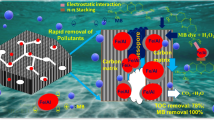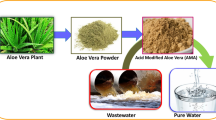Abstract
Herein, nitrogen and sulfur co-doped carbon nanotubes (NS-CNT) adsorbents were synthesized via the chemical vapor deposition technique at 1000°C by employing the camphor, urea and sulfur trioxide pyridine. In this study, desulfurization of two types of mercaptans (dibenzothiophene (DBT) and tertiary butyl mercaptan (TBM) as nonlinear and linear forms of mercaptan) was studied. In this regard, a maximum capacity of NS-CNT was obtained as 106.9 and 79.4 mg/g and also the removal efficiencies of 98.6% and 88.3% were achieved after 4 h at 298K and 0.9 g of NS-CNT for DBT and TBM, respectively. Characterization of the NS-CNTs was carried out through exploiting scanning electron microscopy (SEM), X-ray diffraction (XRD), Fourier transform infrared spectroscopy (FTIR), and elemental analysis (CHN). The isotherm equilibrium data could be ascribed to the Freundlich nonlinear regression form and the kinetic data was fitted by nonlinear form of the pseudo second order model. The negative values of ΔS0, ΔH0 and ΔG0 specify that the adsorption of both types of mercaptans was a natural exothermic process with a reduced entropy. Maintenance of more than 96% of the adsorption capacity even after nine cycles suggest the NS-CNT as a superior adsorbent for mercaptans removal in the industry. Density functional theory (DFT) calculations were also performed to peruse the effects of S/N co-doping and carbon monovacancy defects in CNTs toward the adsorption of DBT and TBM.

Similar content being viewed by others
References
Ahmadi M, Anvaripour B, Khosravi-Nikou M R, Mohammadian M (2017). Selective denitrogenation of model fuel through iron and chromium modified microporous materials (MSU-S). Journal of Environmental Chemical Engineering, 5(1): 849–860
Ahmadi M, Mohammadian M, Khosravi-Nikou M R, Baghban A (2019). Experimental, kinetic, and thermodynamic studies of adsorptive desulfurization and denitrogenation of model fuels using novel mesoporous materials. Journal of Hazardous Materials, 374: 129–139
Anbia M, Karami S (2015). Desulfurization of gasoline using novel mesoporous carbon adsorbents. Journal of Nanostructure in Chemistry, 5(1): 131–137
Arcibar-Orozco J A, Rangel-Mendez J R (2013). Model diesel denitrogenation by modified activated carbon with iron nanoparticles: Sulfur compounds effect. Chemical Engineering Journal, 230: 439–446
Barzamini R, Falamaki C, Mahmoudi R (2014). Adsorption of ethyl, iso-propyl, n-butyl and iso-butyl mercaptans on AgX zeolite: Equilibrium and kinetic study. Fuel, 130: 46–53
Charlier J C (2002). Defects in carbon nanotubes. Accounts of Chemical Research, 35(12): 1063–1069
Chen G, Tan S, Koros W J, Jones C W (2015). Metal organic frameworks for selective adsorption of t-butyl mercaptan from natural gas. Energy & Fuels, 29(5): 3312–3321
Chen Z, Ling L, Wang B, Fan H, Shangguan J, Mi J (2016). Adsorptive desulfurization with metal-organic frameworks: A density functional theory investigation. Applied Surface Science, 387: 483–490
Chowanietz V, Pasel C, Luckas M, Bathen D (2016). Temperature dependent adsorption of sulfur components water, and carbon dioxide on a silica alumina gel used in natural gas processing. Journal of Chemical & Engineering Data, 61(9): 3208–3216
Delley B (2000). From molecules to solids with the DMol 3 approach. Journal of Chemical Physics, 113(18): 7756–7764
Erses A S, Fazal M A, Onay T T, Craig W H (2005). Determination of solid waste sorption capacity for selected heavy metals in landfills. Journal of Hazardous Materials, 121(1–3): 223–232
Evdokimov IN (2019). Colloidal asphaltenes non-extinct dinosaurs in native petroleum. Energy & Fuels, 33(9): 844–8447
Fierro V, Torne-Fernandez V, Montan D, Celzard A (2008). Adsorption of phenol onto activated carbons having different textural and surface properties. Microporous and Mesoporous Materials, 111(1–3): 276–284
Girimonte R, Formisani B, Testa F (2017). Adsorption of CO2 on a confined fluidized bed of pelletized 13X zeolite. Powder Technology, 311: 9–17
Grimme S (2004). Accurate description of van der Waals complexes by density functional theory including empirical corrections. Journal of Computational Chemistry, 25(12): 1463–1473
Grimme S (2006). Semiempirical GGA-type density functional constructed with a long-range dispersion correction. Journal of Computational Chemistry, 27(15): 1787–1799
Hamdaoui O, Naffrechoux E (2007). Modeling of adsorption isotherms of phenol and chlorophenols onto granular activated carbon: Part I. Two-parameter models and equations allowing determination of thermodynamic parameters. Journal of Hazardous Materials, 147(1–2): 381–394
Hosseini-Dastgerdi Z, Meshkat S S (2019). An experimental and modeling study of asphaltene adsorption by carbon nanotubes from model oil solution. Journal of Petroleum Science Engineering, 174: 1053–1061
Huang T, Peng Q, Shi W, Xu J, Fan Y (2018). An anionic surfactant-assisted equilibrium adsorption method to prepare highly dispersed Fe-promoted Ni/Al2O3 catalysts for highly selective mercaptan removal. Applied Catalysis B: Environmental, 230: 154–164
Kwon T, Nishihara H, Itoi H, Yang Q H, Kyotani T (2009). Enhancement mechanism of electrochemical capacitance in nitrogen-/boron-doped carbons with uniform straight nanochannels. Langmuir, 25(19): 11961–11968
Le-Minh N, Sivret E C, Shammay A, Stuetz R M (2018). Factors affecting the adsorption of gaseous environmental odors by activated carbon: A critical review. Critical Reviews in Environmental Science and Technology, 48(4): 341–375
Li Y, Wang L J, Fan H L, Shangguan J, Wang H, Mi J (2015). Removal of sulfur compounds by a copper-based metal organic framework under ambient conditions. Energy & Fuels, 29(1): 298–304
Liu Q, Ke M, Liu F, Yu P, Hu H, Li C (2017). High-performance removal of methyl mercaptan by nitrogen-rich coconut shell activated carbon. RSC Advances, 7(37): 22892–22899
Liu Q, Ke M, Yu P, Liu F, Hu H, Li C (2018). High performance removal of methyl mercaptan on metal modified activated carbon. Korean Journal of Chemical Engineering, 35(1): 137–146
Liu X, Kaminski M D, Guan Y, Chen H, Liu H, Rosengart A J (2006). Preparation and characterization of hydrophobic superparamagnetic magnetite gel. Journal of Magnetism and Magnetic Materials, 306(2): 248–253
Ma X, Liu H, Li W, Peng S, Chen Y (2016). Reactive adsorption of low concentration methyl mercaptan on a Cu-based MOF with controllable size and shape. RSC Advances, 6(99): 96997–97003
Meshkat S S, Rashidi A, Tavakoli O (2018a). Removal of mercaptan from natural gas condensate using N-doped carbon nanotube adsorbents: kinetic and DFT study. Journal of Natural Gas Science and Engineering, 55: 288–297
Meshkat S S, Tavakoli O, Rashidi A, Esrafili M D (2018b). Adsorptive mercaptan removal of liquid phase using nanoporous graphene: Equilibrium, kinetic study and DFT calculations. Ecotoxicology and Environmental Safety, 165: 533–539
Mohammadian M, Ahmadi M, Khosravi-Nikou M R (2017). Adsorptive desulfurization and denitrogenation of model fuel by mesoporous adsorbents (MSU-S and CoO-MSU-S). Petroleum Science and Technology, 35(6): 608–614
Mohammadian M, Khosravi-Nikou M R, Shariati A, Aghajani M (2018). Model fuel desulfurization and denitrogenation using copper and cerium modified mesoporous material (MSU-S) through adsorption process. Clean Technologies and Environmental Policy, 20(1): 95–112
Peng S, Li W, Deng Y, Li W, Ma X, Chen Y (2018). Removal of low concentration CH3SH with regenerable Cu-doped mesoporous silica. Journal of Colloid and Interface Science, 513: 903–910
Perdew J P, Burke K, Ernzerhof M (1996). Generalized gradient approximation made simple. Physical Review Letters, 77(18): 3865–3868
Rashidi S, Khosravi Nikou M R, Anvaripour B (2015). Adsorptive desulfurization and denitrogenation of model fuel using HPW and NiO-HPW modified aluminosilicate mesostructures. Microporous and Mesoporous Materials, 211: 134–141
Reddad Z, Gerente C, Andres Y, Le Cloirec P (2002). Adsorption of several metal ions onto a low-cost biosorbent: kinetic and equilibrium studies. Environmental Science & Technology, 36(9): 2067–2073
Ryzhikov A, Hulea V, Tichit D, Leroi C, Anglerot D, Coq B, Trens P (2011). Methyl mercaptan and carbonyl sulfide traces removal through adsorption and catalysis on zeolites and layered double hydroxides. Applied Catalysis A, General, 397(1–2): 218–224
Shirani B, Kaghazchi T, Beheshti M (2010). Water and mercaptan adsorption on 13X zeolite in natural gas purification process. Korean Journal of Chemical Engineering, 27(1): 253–260
Suenaga K, Wakabayashi H, Koshino M, Sato Y, Urita K, Iijima S (2007). Imaging active topological defects in carbon nanotubes. Nature Nanotechnology, 2(6): 358–360
Sun B, Li G, Wang X (2010). Facile synthesis of microporous carbon through a soft-template pathway and its performance in desulfurization and denitrogenation. Journal of Natural Gas Chemistry, 19(5): 471–476
Wang L, Zhu D, Duan L, Chen W (2010). Adsorption of single-ringed N-and S-heterocyclic aromatics on carbon nanotubes. Carbon, 48(13): 3906–3915
Wen J, Han X, Lin H, Zheng Y, Chu W (2010). A critical study on the adsorption of heterocyclic sulfur and nitrogen compounds by activated carbon: equilibrium, kinetics and thermodynamics. Chemical Engineering Journal, 164(1): 29–36
Yang C, Wang J, Fan H L (2017). Three-dimensionally ordered macroporous metaloxide-silica composite forremovalofmercaptan. Research on Chemical Intermediates, 43(7): 3847–3858
Yang G, Wan X, Su Y, Zeng X, Tang J (2016). Acidophilic S-doped carbon quantum dots derived from cellulose fibers and their fluorescence sensing performance for metal ions in an extremely strong acid environment. Journal of Materials Chemistry. A, Materials for Energy and Sustainability, 4(33): 12841–12849
Yang J, Zhang Q, Zhang F, Xia D, Liu H, Tian S, Sun L, Shu D, He C, Runa S (2018). Three-dimensional hierarchical porous sludge-derived carbon supported on silicon carbide foams as effective and stable Fenton-like catalyst for odorous methyl mercaptan elimination. Journal of Hazardous Materials, 358: 136–144
Zhang L, Han C, Wang H, Pu H, Du D, Li J, Luo Y (2012). One-step synthesis of mesoporous nanosized sulfated zirconia via liquid-crystal template (LCT) method. Materials Research Bulletin, 47(11): 3931–3936
Zhao A, Masa J, Schuhmann W, Xia W (2013). Activation and stabilization of nitrogen-doped carbon nanotubes as electrocatalysts in the oxygen reduction reaction at strongly alkaline conditions. Journal of Physical Chemistry C, 117(46): 24283–24291
Zhao S, Yi H, Tang X, Gao F, Zhang B, Wang Z, Zuo Y (2015). Methyl mercaptan removal from gas streams using metal-modified activated carbon. Journal of Cleaner Production, 87: 856–861
Zhu L, Jia X, Bian H, Huo T, Duan Z, Xiang Y, Xia D (2018). Structure and adsorptive desulfurization performance of the composite material MOF-5@ AC. New Journal of Chemistry, 42(5): 3840–3850
Author information
Authors and Affiliations
Corresponding authors
Additional information
Highlights
• Synthesis of NS-CNTS is used in a high desulfurization performance.
• Synthesizing NS-CNT is considered as a novel adsorbent from low-cost precursors.
• A high sulfur removal capacity for NS-CNT is attained compared with recent works.
Supporting materials
Rights and permissions
About this article
Cite this article
Meshkat, S.S., Ghasemy, E., Rashidi, A. et al. Experimental and DFT insights into nitrogen and sulfur co-doped carbon nanotubes for effective desulfurization of liquid phases: Equilibrium & kinetic study. Front. Environ. Sci. Eng. 15, 109 (2021). https://doi.org/10.1007/s11783-021-1397-3
Received:
Revised:
Accepted:
Published:
DOI: https://doi.org/10.1007/s11783-021-1397-3




